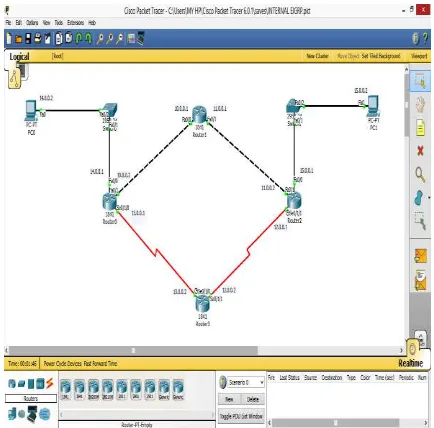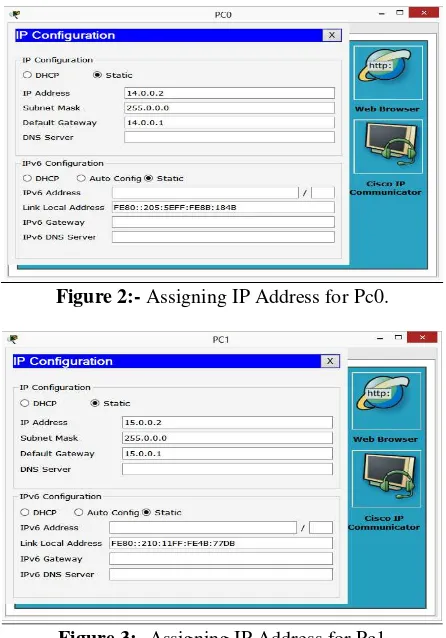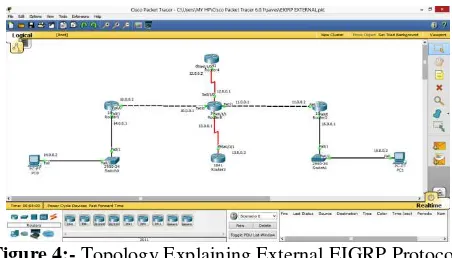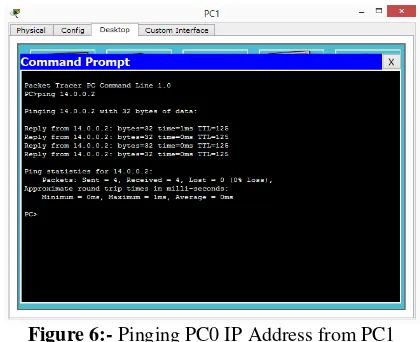Journal Homepage: - www.journalijar.com
Article DOI:10.21474/IJAR01/4734
DOI URL: http://dx.doi.org/10.21474/IJAR01/4734
RESEARCH ARTICLE
CONFIGURATION AND DETAILED ANALYSIS OF ENHANCED INTERIOR GATEWAY ROUTING PROTOCOL (EIGRP) USING CISCO PACKET TRACER.
Anchit Bansal and Priyanka Goel.
Department of Electronics & Communication Engineering SITE, SVSU, Meerut (U.P), India.
………....
Manuscript Info
Abstract
……….
………
Manuscript History
Received: 4 May 2017 Final Accepted: 6 June 2017 Published: July 2017
Key words:-
EIGRP, Routing Protocol, Packet Tracer, Router Configuration, Simulation, IP Address, DUAL.
Routing Protocols play a major role in today‟s internet era. The term
routing is used for selecting a path for traffic in a network, or between or across multiple networks. Routers need routing protocols so that the routers become aware of all the possible routes and add them to their routing table, so that the routing process can forward (route) routable protocols such as IP. An efficient routing protocol forwards router update packets from a source node to a destination node through an optimal path and at the same time does not send many routing update packets thus maintaining the convergence of the network. In this paper we have shown how routing is done using an EIGRP based routing protocol. A network model of Cisco routers has been employed in a network simulation software „packet tracer‟. The results are verified using ping command. The paper also explains the process of assigning
ip addresses and their configuration in routers as well as in pc‟s.
Copy Right, IJAR, 2017,. All rights reserved.
………....
Introduction:-
By the early 1990s, business and technical factors pushed the IPv4 world toward a second wave of better routing protocols. Many enterprises switched from older vendor-proprietary networks to networks built with routers, LANs, and TCP/IP. These businesses needed better performance from their routing protocols, including better metrics and better convergence. All these factors led to the introduction of a new wave of IPv4 Interior routing protocol: EIGRP. (EIGRP) is a classless, enhanced distance vector protocol that gives us a real edge over another Cisco proprietary
EIGRP Metrics:-
Unlike many other protocols that use a single factor to compare routes and select the best possible path, EIGRP can use a combination of five:
1) Bandwidth- Slowest link in the route path, measured in kilobits.
2) Delay- Cumulative delay of all outgoing interfaces in the path in tens of microseconds. 3) Load- Cumulative load of all outgoing interfaces in the path, given as a fraction of 255 4) Reliability- Average reliability of all outgoing interfaces in the path, given as a fraction of 255
5) MTU- The value of the MTU element represents the smallest MTU value encountered along the path to the destination network.
EIGRP uses only bandwidth and delay of the line to determine the best path to a remote network by default. This element EIGRP provides a more granular metric by multiplying the bandwidth and delay by 256. Maximum transmission unit (MTU) size has never been used in EIGRP calculations, but it‟s a required parameter in some EIGRP related commands, especially those involving redistribution. Bandwidth and delay are determined by the interfaces that lead towards the destination network.
By default, the full formula for determining the EIGRP metric is: [10000000/bandwidth + delay/10] * 256
The bandwidth value represents the link with the lowest bandwidth in the path, in kilobits. The delay is the total delay of all outgoing interfaces in the path.
EIGRP Tables & Packet
Types:-EIGRP forms neighbor relationships, called adjacencies with other routers in the same AS by exchanging Hello packets. Only after an adjacency is formed can routers share routing information. Hello packets are sent as multicasts to address 224.0.0.10. EIGRP Hellos are sent every 5 seconds. In addition to the Hello timer, EIGRP neighbors are stamped with a Hold timer. The Hold timer indicates how long a router should wait before marking a neighbor inactive, if it stops receiving hello packets from that neighbor. By default, the Hold timer is three times the Hello timer. Thus, on high speed links the timer is set to 15 seconds.
EIGRP, much like OSPF, builds three separate tables:
1. Neighbor Table:- List of all neighboring routers. Neighbors must belong to the same Autonomous System. If connecting interfaces are on different subnets, an EIGRP router will log the following error to console when a multicast Hello is received:
00:10:24:IP-EIGRP:Neighbor 192.168.1.2 not on common subnet for Serial0
Always ensure that primary IP addresses belong to the same subnet between EIGRP neighbors.
2. Topology Table:- List of all routes in the Autonomous System. Each router‟s update contains a list of all routes known by that router, and the respective metrics for those routes. To allow convergence to occur quickly if a link fails, EIGRP includes backup routes in the topology table called Feasible Successors (FS).A route will only become a Successor if its Advertised Distance is less than the current Feasible Distance. This is known as a Feasible Condition (FC).
3. Routing Table:- Contains the best route for each known network. The route with the lowest metric to each network will become the Feasible Distance (FD). The Feasible Distance for each network will be installed into the routing table.
EIGRP employs five packet types:
A. Hello Packets:-These packets come in use to form neighbor relationships. Hello packets are always multicast to address 224.0.0.10.
C. Query packets:- These packets are sent by a router when a Successor route fails, and there are no Feasible Successors in the topology table. The router places the route in an Active state, and queries its neighbors for an alternative route. Query packets are sent as a multicast to address 224.0.0.10.
D. Reply packets:- These packets are sent in response to Query packets, assuming the responding router has an alternative route (feasible successor). Reply packets are sent as a unicast to the querying router.
E. Acknowledgment packets:- These are simply Hello packets with no data, other than an acknowledgment
number. ACK‟s are always sent as unicasts.
Topology For Configuring Internal EIGRP
Protocol:-The topology consists of four routers (1841), two switches (2950-24), two pc‟s (PC0 & PC1). Pc‟s are connected to switches via copper-straight through cables and the same are used to connect switches to routers. Router fast Ethernet ports are inter-connected using copper cross-over cables while serial ports are connected using serial DTE cables. While making connections it must be remembered that Fast Ethernet ports of like devices (routers-routers, switches-switches) are always connected using copper cross-over cables whereas the connections between different devices (routers-switches, switches-pc‟s, routers-pc‟s) are always done using copper-straight through cables. In packet tracer pc consists of two ports RS 232 and Fast Ethernet0 ports. For transfer of data the Fast Ethernet0 port of pc is used to make connections.
Figure 1:- Topology Explaining Internal EIGRP Protocol.
Configuration of The EIGRP Protocol For The Considered Topology:-
After constructing the network and making connections as described in the above figure, ip addresses will be
Figure 2:- Assigning IP Address for Pc0.
Figure 3:- Assigning IP Address for Pc1
Now configuration of network with EIGRP routing protocol is done. There are two modes by which EIGRP commands are entered: router configuration mode and interface configuration mode. Router configuration mode enables the protocol, determines which networks will run EIGRP, and sets global characteristics. Interface configuration mode allows customization of summaries, metrics, timers, and bandwidth.
A. Router 0 Configuration:-
--- System Configuration Dialog ---
Continue with configuration dialog? [yes/no]: n Press RETURN to get started!
Router>enable
Router# configure terminal
Enter configuration commands, one per line. End with CNTL/Z. Router(config)#intfa 0/0
Router(config-if)#ip address 14.0.0.1 255.0.0.0 Router(config-if)#no shutdown
%LINK-5-CHANGED: Interface FastEthernet0/0, changed state to up Router(config-if)#exit
Router(config)#intfa 0/1
Router(config-if)#ip address 10.0.0.2 255.0.0.0 Router(config-if)#no shutdown
%LINK-5-CHANGED: Interface FastEthernet0/0, changed state to up Router(config-if)#exit
Router(config)#int se 0/1/0
Router(config-if)#ip address 13.0.0.1 255.0.0.0 Router(config-if)#no shutdown
B. Router 1
Configuration:---- System Configuration Dialog Configuration:----
Continue with configuration dialog? [yes/no]: n Press RETURN to get started!
Router>enable
Router# configure terminal
Enter configuration commands, one per line. End with CNTL/Z. Router(config)#intfa 0/0
Router(config-if)#ip address 10.0.0.1 255.0.0.0 Router(config-if)#no shutdown
%LINK-5-CHANGED: Interface FastEthernet0/0, changed state to up Router(config-if)#exit
Router(config)#intfa 0/1
Router(config-if)#ip address 11.0.0.1 255.0.0.0 Router(config-if)#no shutdown
%LINK-5-CHANGED: Interface FastEthernet0/0, changed state to up
C. Router 2
Configuration:---- System Configuration Dialog Configuration:----
Continue with configuration dialog? [yes/no]: n Press RETURN to get started!
Router>enable
Router# configure terminal
Enter configuration commands, one per line. End with CNTL/Z. Router(config)#intfa 0/0
Router(config-if)#ip address 15.0.0.1 255.0.0.0 Router(config-if)#no shutdown
%LINK-5-CHANGED: Interface FastEthernet0/0, changed state to up Router(config-if)#exit
Router(config)#intfa 0/1
Router(config-if)#ip address 11.0.0.2 255.0.0.0 Router(config-if)#no shutdown
%LINK-5-CHANGED: Interface FastEthernet0/0, changed state to up Router(config-if)#exit
Router(config)#int se 0/1/1
Router(config-if)#ip address 12.0.0.1 255.0.0.0 Router(config-if)#no shutdown
%LINK-5-CHANGED: Interface Serial0/1/1, changed state to down Router(config-if)#exit
D. Router 3
Configuration:---- System Configuration Dialog Configuration:----
Continue with configuration dialog? [yes/no]: n Press RETURN to get started!
Router>enable
Router# configure terminal
Enter configuration commands, one per line. End with CNTL/Z. Router(config)#int se 0/1/0
Router(config-if)#ip address 13.0.0.2 255.0.0.0 Router(config-if)#no shutdown
%LINK-5-CHANGED: Interface Serial0/1/0, changed state to up Router(config-if)#exit
Router(config)#int se 0/1/1
Router(config-if)#ip address 12.0.0.2 255.0.0.0 Router(config-if)#no shutdown
To start an EIGRP session on a router, use the router eigrp command followed by the autonomous system number of your network. The procedure for configuring Cisco routers is as follows:
Router 0 Configuration:-
Router>enable
Router#configure terminal
Enter configuration commands, one per line. End with CNTL/Z. Router(config)#router eigrp 1
Router(config-router)#network 10.0.0.0 Router(config-router)#
%DUAL-5-NBRCHANGE: IP-EIGRP 1: Neighbor 10.0.0.1 (FastEthernet0/1) is up: new adjacency Router(config-router)#network 13.0.0.0
Enter configuration commands, one per line. End with CNTL/Z. Router(config)#router eigrp 1
Enter configuration commands, one per line. End with CNTL/Z. Router(config)#router eigrp 1
Router(config-router)#network 11.0.0.0 Router(config-router)#
%DUAL-5-NBRCHANGE: IP-EIGRP 1: Neighbor 11.0.0.1 (FastEthernet0/1) is up: new adjacency Router(config-router)#network 12.0.0.0
Enter configuration commands, one per line. End with CNTL/Z. Router(config)#router eigrp 1
Router(config-router)#network 12.0.0.0 Router(config-router)#
%DUAL-5-NBRCHANGE: IP-EIGRP 1: Neighbor 12.0.0.1 (Serial0/1/1) is up: new adjacency Router(config-router)#network 13.0.0.0
Router(config-router)#
%DUAL-5-NBRCHANGE: IP-EIGRP 1: Neighbor 13.0.0.1 (Serial0/1/0) is up: new adjacency Router(config-router)#exit
Actually the command router eigrp 1 means that we configuring the router using eigrp protocol and 1 refers to Autonomous system number and its range is (1-65535).
Topology For Configuring External EIGRP Protocol:-
Figure 4:- Topology Explaining External EIGRP Protocol.
Configuration of The EIGRP Protocol For The Considered Topology:-
After making the connections as described in the topology address will be assigned to the pc‟s and on the ports of
routers. The procedure for the same is already discussed while configuring internal eigrp as explained above. The difference comes in the AS number which is different on different routers in external eigrp. The configuration for the same is as follows:
Router 1 Configuration:-
Router>enable
Router#configure terminal
Enter configuration commands, one per line. End with CNTL/Z. Router(config)#router eigrp 1
Router(config-router)#network 10.0.0.0 Router(config-router)#network 14.0.0.0 Router(config-router)#exit
Router(config)#exit Router#write
Router 2
Configuration:-Router>enable
Router#configure terminal
Enter configuration commands, one per line. End with CNTL/Z. Router(config)#router eigrp 2
Router(config-router)#network 11.0.0.0 Router(config-router)#network 15.0.0.0 Router(config-router)#exit
Router(config)#exit Router#write
Router 3
Configuration:-Router>enable
Router#configure terminal
Enter configuration commands, one per line. End with CNTL/Z. Router(config)#router eigrp 3
Router(config-router)#network 13.0.0.0 Router(config-router)#exit
Router(config)#exit Router#write
Router 4 Configuration:-
Router>enable
Router#configure terminal
Enter configuration commands, one per line. End with CNTL/Z. Router(config)#router eigrp 4
Router(config-router)#exit
Enter configuration commands, one per line. End with CNTL/Z. Router(config)#router eigrp 1
%DUAL-5-NBRCHANGE: IP-EIGRP 1: Neighbor 10.0.0.2 (FastEthernet0/0) is up: new adjacency Router(config-router)#exit
%DUAL-5-NBRCHANGE: IP-EIGRP 2: Neighbor 11.0.0.2 (FastEthernet0/1) is up: new adjacency Router(config-router)#exit
%DUAL-5-NBRCHANGE: IP-EIGRP 3: Neighbor 13.0.0.2 (Serial0/1/1) is up: new adjacency Router(config-router)#exit
%DUAL-5-NBRCHANGE: IP-EIGRP 4: Neighbor 12.0.0.2 (Serial0/1/0) is up: new adjacency Router(config-router)#^Z
Router#
%SYS-5-CONFIG_I: Configured from console by console Router#write
Building configuration... [OK]
Verifying The Topology:-
We can easily check or verify the topology using the ping command. We will check the flow of packets for both internal & external eigrp. The process is as follows:
A. Internal EIGRP:-
Figure 5:- Pinging PC1 IP Address from PC0
As depicted from the figure PC0 receives replies from PC1. Thus we can say that Internal EIGRP protocol is successfully configured.
B. External EIGRP:-
The same procedure will be applied as used in Internal EIGRP. We will open command prompt of PC1 and will ping the port address of PC0.
Figure 6:- Pinging PC0 IP Address from PC1
Since all the packets sent are successfully received therefore we can say that External EIGRP protocol is successfully configured.
Conclusion:-
Routing is basically tracing a path for packets to follow from source to destination. EIGRP is the first internet routing protocol that provides loop freedom and convergence times comparable to those obtained with standard link state protocols. Furthermore, EIGRP provides multiple paths to every destination that may have different weights. In this paper, the EIGRP protocol has explained and configured successfully using the Cisco packet tracer and the results are explained.
References:-
1. “EIGRP Network Design Solutions: The Definitive Resource for EIGRP Design, Deployment, and Operation‟‟
by Ivan Pepelnjak.
2. D.Bertsekas and R.Gallager, Data Network, Second Edition, Prentice-Hall, 1992.
4. A.S.Tanenbaum. Computer Networks.Prentice-Hall,2002.
5. F.Bertocchi, P.Bergamo, G.Mazzin, “Performance Comparison of Routing Protocols for AdHoc Networks”, IEEEGLOBECOM2003.
6. GertDe L. and GertS.,Network Security Fundamentals, Publisher Cisco Press, 2004.
7. A. Balchunas. (2007). Static vs. dynamic routing. [Online].
Available:http://www.routeralley.com/ra/docs/static_dynamic_routing.pdf -unpublished.
8. O. J. S. Parra, A. P. Rios, and G. L. Rubio, "IPV6 and IPV4 QoS Mechanisms," in Proc. of International Organization for Information Integration and Web-based Application and Services, 2011, pp. 463-466.
9. A. Riesco and A. Verdejo, "Implementing and analyzing in Maude the Enhanced Interior Gateway Routing Protocol," Electronic Notes in Theoretical Computer Science, 2009, pp. 249–266.



